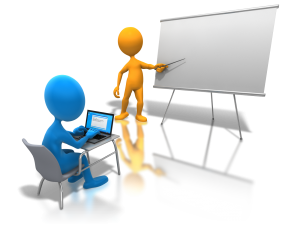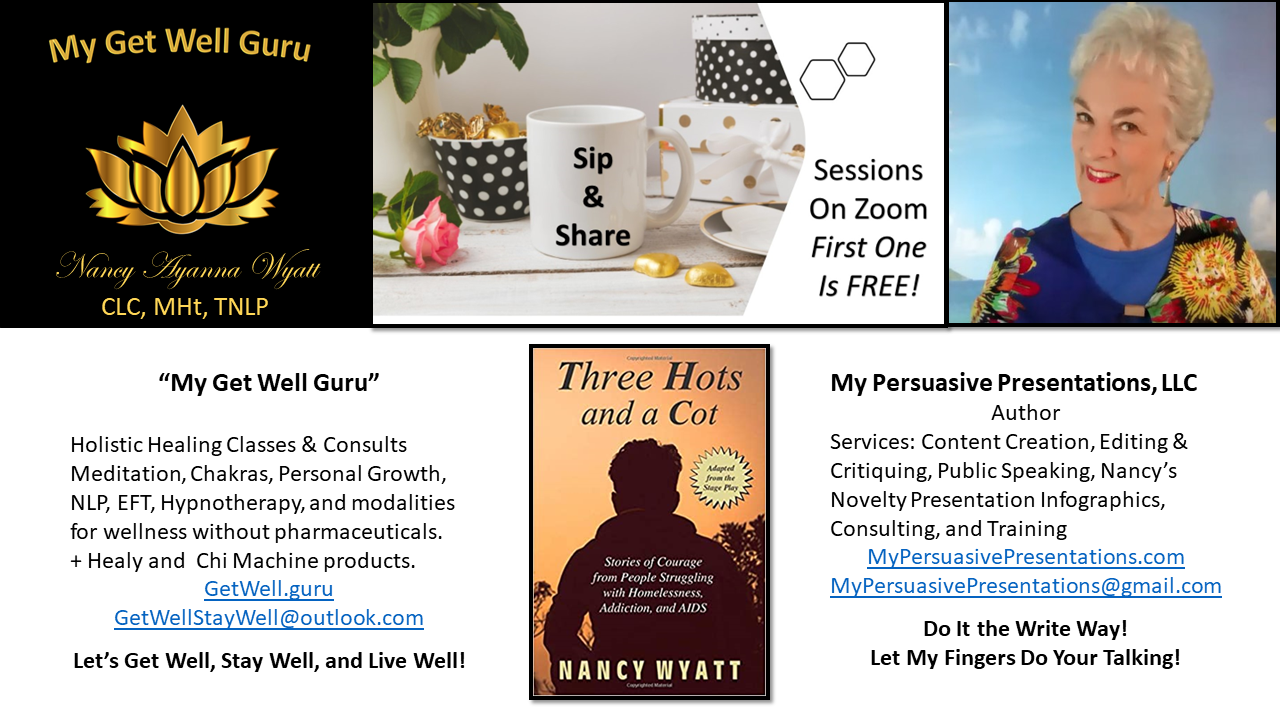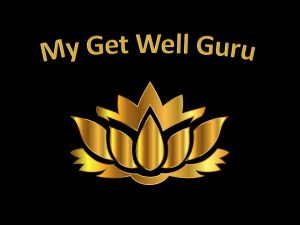Pain Hurts! (no kidding) What to Do About It
Under the auspices of the Virginia Department of Health, Prince William Area Agency on Aging, I completed the certification coursework for teaching people how to deal with chronic illness. Then, the COVID-19 pandemic hit, and the final practice classes were canceled. However, I learned about several things that influence chronic conditions, including pain, and most of them confirm what I already knew and have talked about as a certified practitioner of healing modalities over many years. You may have seen my posts or have been in my classes about:
Influences Affecting Chronic Pain Levels
- balancing emotions – establishing methods – (e.g., physical activity, meditation, listening to music, hypnotherapy, counseling, etc.) for relieving anxiety and depression
- breathing – shallowly or consciously, deeply, and purposefully (There are many techniques with differing emphasis on various parts of the body.)
- evaluating nutritional intake – proper – or inflammatory and bone-deconstructing foods and drinks
- exercising – mental (learning helpful, practical skills; keeping mentally alert; distracting oneself from pain)
- exercising – physical (how much, when, and whether to do it while in pain) (aerobic exercise for immobile people – the chi machine)
- making decisions – avoided or done well (with the help of a coach, counselor, or caregiver, if necessary)
- sleeping – well or poorly (the amount needed and techniques for inducing restful sleep and for avoiding disrupted sleep. Since I’m not going into detail here, I’ll just share the link to my Sleep Like a Baby guided meditation which is available wherever you get your audio media. It put the sound engineer to sleep mid-recording session!)
- using self-management tasks, like:
- scheduling medications and making lists of questions for health care providers
- acquiring tools and other aids needed to accomplish functions that used to be easy (like step stools for reaching high shelves or shoe hooks for inserting feet into shoes without having to bend down)
- creating a plan to address emergencies
- using holistic healing modalities, like Reiki, massage, hypnotherapy, and natural foods and herbs. Click Here for more tools and tips.
You Can Take the Self-Management Class for Chronic Pain and/or Illness!

You don’t need ME.
The Centers for Disease Control and Prevention website describes the certification program in which I participated. (see excerpt below). It uses a protocol developed by Stanford University. “Stanford University’s widely tested Chronic Disease Self-Management Program helps those living with a chronic health condition improve their general health. A 6-week, once-a-week program, participants that attend the workshop will receive a free copy of the Living a Healthy Life with Chronic Condition book, and a relaxation CD, Relaxation for Mind and Body.”

There have been many advancements and studies in nutrition since the Stanford protocol was developed. Some of the findings are contradictory, so I don’t subscribe to everything in that portion of the program. However, the nutrition guidelines that Stanford suggests have proven successful in many people throughout the years, so they may work for you. I agree with the rest of the suggestions in the program. They can be very helpful to the people in pain and for the caregivers who are helping them.
The materials were copyrighted by SMRC (Self Management Resource Center, LLC) in 2012. This program is taught throughout the country, so you may access it locally. Here is a descriptive excerpt from the CDC.
Managing Chronic Pain
“About 50 million US adults have chronic pain, which is one of the most common reasons adults seek medical care. Chronic pain can happen for many reasons including as a result of chronic conditions (e.g. arthritis and diabetes), autoimmune disorders (e.g. lupus), past injuries, and other reasons. Chronic pain can limit quality of life. For some people with chronic pain, there may not be obvious evidence of an underlying reason. Managing chronic pain can be difficult.
If you have chronic pain, learn how a self-management education (SME) program may help you control your pain. Find out how an SME program may help you learn more and feel better.
General Chronic Disease SME Programs
The SME programs that follow are for people with any chronic health condition.
Chronic Disease Self-Management Program
Cost: The cost varies by organization, but rarely is more than $50.Format: This course is offered as an in-person workshop.
About the Program
The Chronic Disease Self-Management Program is an interactive workshop for people with all types of chronic conditions. Stanford University developed this course to help people with one or more chronic conditions learn the strategies to manage their condition and have the confidence to carry them out.
Program Details
This interactive workshop meets for 2.5 hours per week for 6 weeks in convenient community locations. The instructors are trained leaders, at least one of whom has a chronic condition. This workshop is known by a variety of different names, including Living Well.
The program is also available in Spanish.
Subjects covered include:
- Techniques to deal with problems such as frustration, fatigue, pain, and isolation.
- Appropriate exercise for maintaining and improving strength, flexibility, and endurance.
- Appropriate use of medications.
- Communicating effectively with family, friends, and health professionals.
- Managing depression.
- Better breathing techniques.
- Relaxation techniques.
- Healthy eating habits.
- Making good decisions about your health.
- How to evaluate new treatments.
- Visit the Self-Management Resource Cenisit the Self-Management Resource Center website to learn more….”
So, Why Would You Need Absolution As Relates To Coping with Pain?
You can’t do better if you don’t know better.
- Most of us were taught to “power through” and ignore pain. We learned to go to work when we were sick and to continue playing sports or dancing professionally, no matter what injury or pain we had. We were told it was all “mind over matter” or just to take drugs to numb the sensations.

Now, we know that pain is our soul and body’s messenger telling us that something needs attention. It needs to be addressed while the problem is small – before it gets out of hand. We’re a little too good at ignoring it.
2. We also didn’t know that, when we keep concentrating on the pain repeatedly, we are creating brain pathways that solidify the pain. It might even become an “autopilot” mode for us.

Scientific studies of brain function have taught us a lot recently. Now, we may have to unlearn years of thoughts and behavior in order to reverse the patterns in mind, brain, emotions, and body.

It is important to forgive yourself and release all blame. It is not your fault that you didn’t know more about pain resolution.

Forgiving yourself (giving yourself absolution) will help “open you up” and free you to start – from the present moment – in learning new, productive ways to help yourself endure, overcome, and/or eliminate chronic pain.
Catastrophising Chronic Pain Influences Outcomes
An article in Psychology Today by Dan Mager
Mager begins by pointing out that,
“Chronic pain is pain that lasts more than several months, defined as 3 to 6 months or longer. Chronic pain can last years, eluding anything resembling a “cure.” The CDC reported that in 2016 it was estimated over 20 percent of US citizens—50 million people—reported chronic pain, costing and around $560 billion per year (1). Chronic pain is among the most common reasons adults seek medical care (2), has been linked to restrictions in mobility and daily activities (3,4), dependence on opioids (5), anxiety and depression (3), and poor perceived health or reduced quality of life (3,4)
The most prevalent chronic pain conditions are low-back pain, arthritis pain, headache/migraine, cancer pain, neurogenic pain (pain resulting from damage to the peripheral nerves or to the central nervous system itself)such as fibromyalgia, and psychogenic pain (pain not due to past disease or injury or any visible sign of damage inside or outside the nervous system).
He then discusses the “vicious cycle” that occurs when pain causes people to avoid the very exercise they need to overcome (and, perhaps, cure) the pain.
“One particularly interesting finding is that the detrimental influence of catastrophizing thinking about pain is independent of the pain experience itself,” said assistant research professor Ruixue Zhaoyang. “In other words, how patients think about their pain, rather than the level of experienced pain, had a more powerful impact on their daily physical activity.” Further, as reported by Lynn Martire, professor of human development and family studies, the study demonstrated that pain-related catastrophic thinking can change from day to day and can be modified by everyday activity and behavior.
I hope you will read his entire article.
It’s Not VooDoo
Merriam-Webster Synonyms for voodoo – Synonyms: charmer conjurer (or conjuror) enchanter mage Magian magician magus necromancer sorcerer voodooist witch wizard
 Techniques, like those listed below, may appear to some people to be “voodooistic,” but they are not. Several of these modalities have the support of clinical studies, but others have experiential evidence on which they rely.
Techniques, like those listed below, may appear to some people to be “voodooistic,” but they are not. Several of these modalities have the support of clinical studies, but others have experiential evidence on which they rely.
- transpersonal hypnotherapy
- neuro-linguistic programming (NLP)
- accessing the Akashic Records for influences from other lives
- Pranashakthi healing
- Reiki and alternative energy healing modalities
- plus other “Ancient Wisdom” or “New Age” techniques,
In other words, you might not be able to prove something works or how it works
BUT, if it worked, IT WORKED!
So, be grateful and happy with the result!
I’m certified in most of these modalities, and I can refer you to other people, as well. If you can change how your mind works, you often can change how your body feels and behaves. It’s worth a try when you suffer from chronic pain. Book me for a free initial consultation and/or share comments about something that has worked for you!
Let’s Get Well, Stay Well and Live Well Together Now!



